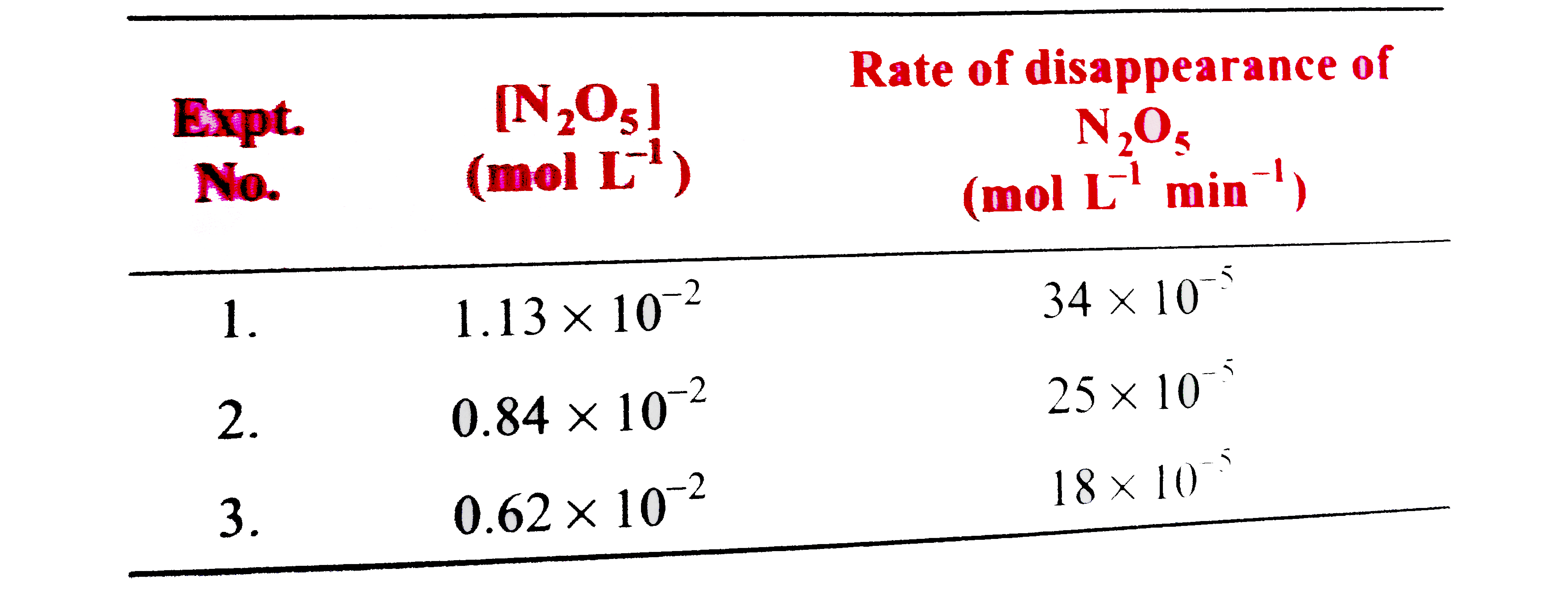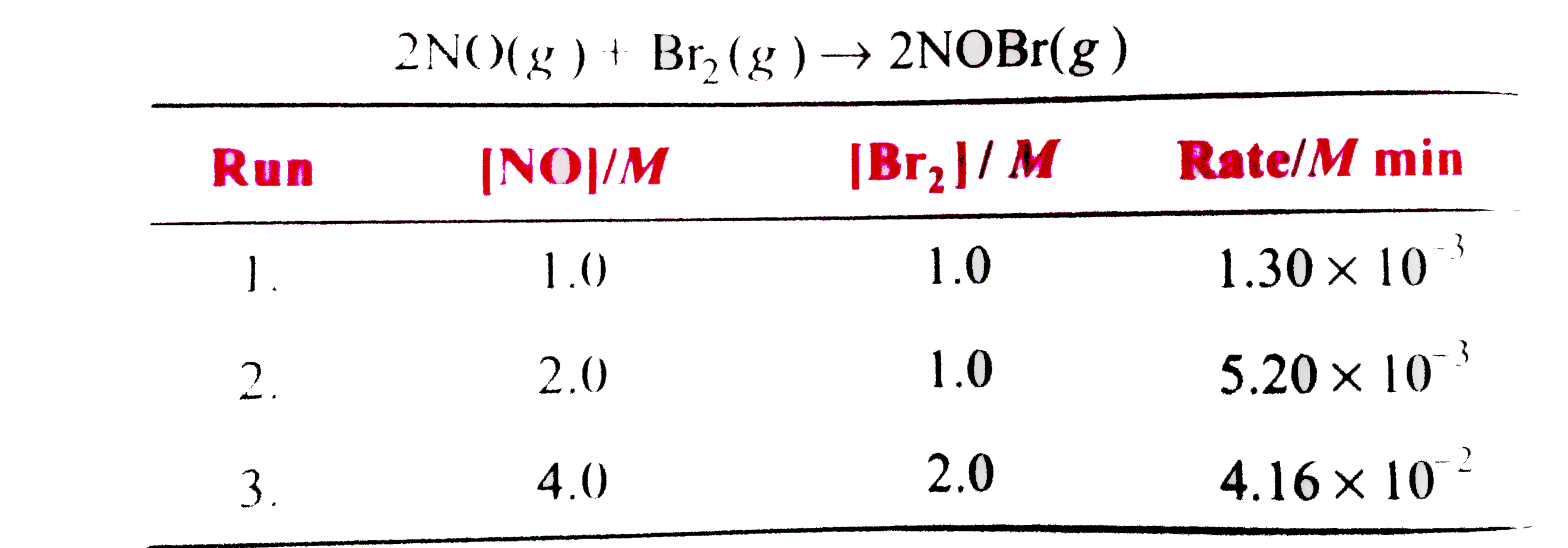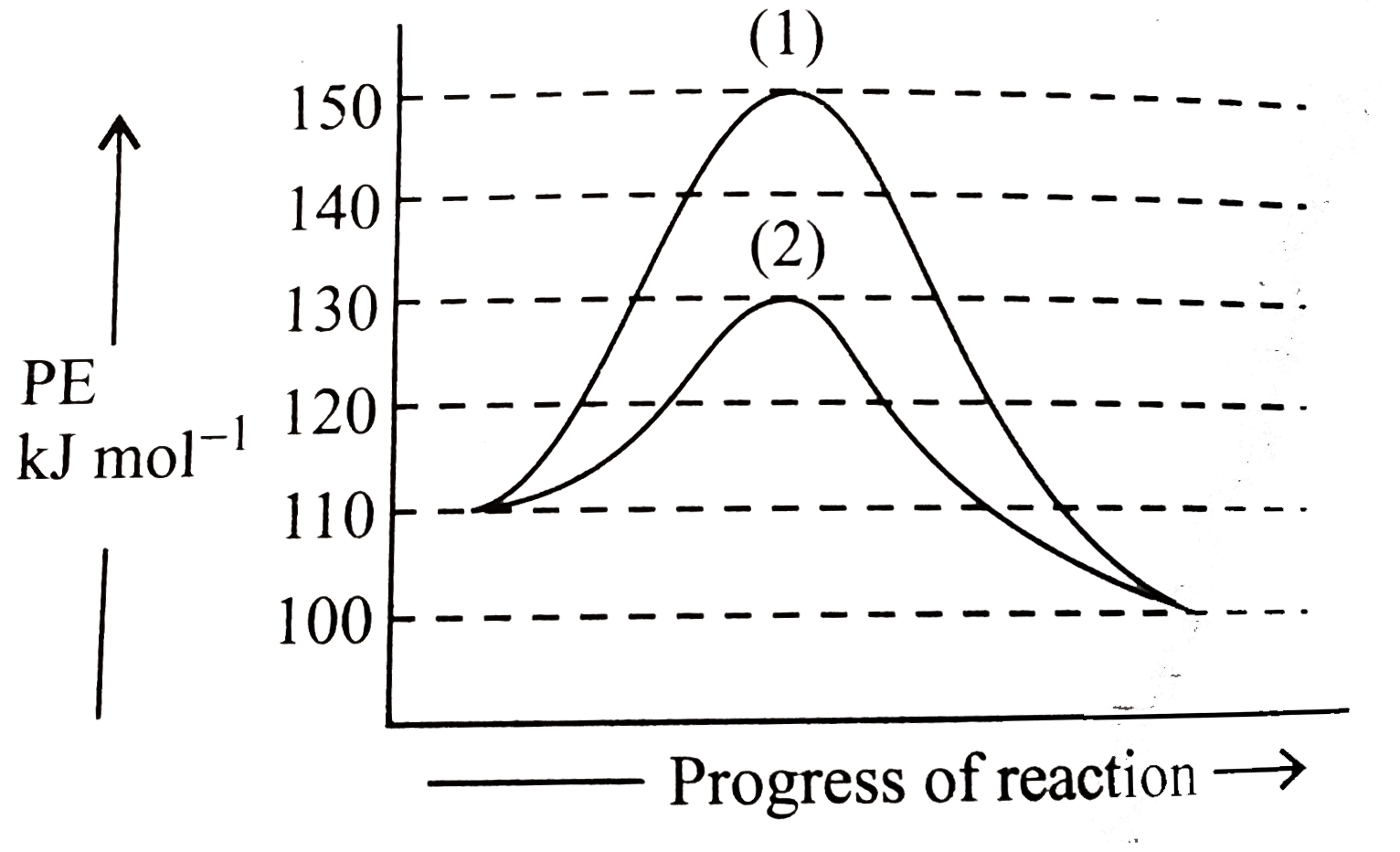Complete Solutions to PRACTICE PROBLEMS of chapter CHEMICAL KINETICS of Class 12 book with complete answers and questions
| Class 12 | CHEMISTRY |
| Chapter | CHEMICAL KINETICS |
| OP TANDON | PRACTICE PROBLEMS |
| Number Of Questions | 70 |
| Academic Year | 2023-24 |
From the reaction `ArarrB` it was found that the concentration of B increased by 0.3 mol `L^(-1)` in 2 hours. What is the average rate of reaction ?
View SolutionIn the reaction `XrarrY`, the initial concentration of Xis 2.5 mol `L^(-1)` and its concentration after 3 hours is 0.7 mol `L^(-1)` . What is the average rate of the reaction ?
View SolutionFor the reaction`2A+BrarrC`, the rate of formation of C is `0.5 "mol" L^(-1)hr^(-1)` . What is the rate of disappearance of A and b?
View SolutionWhen ammonia is treated with `O_(2)` at elevated temperature, the rate of disappearance of ammonia is found to be `3.5xx10^(-2) "mol" dm^(-3)s^(-1)` during a measured time interval. Calculate the rate of appearance of nitric oxide and water.
View SolutionIn a reaction, the concentration of a reatant (A) changes from `0.200 "mol litre"^(-1) to 0.150 "mol litre"^(-1)` in 10 minutes. What is the average rate of reaction during this interval ? `N_(2)O_(5)rarr2NO_(2)+_(1//2)O_(2)` the rate of disappearance of `N_(2)O_(5)"is" 6.5xx10^(-3)"mol" L^(-1)s^(-1)`. Computer the rates of formation of `NO_(2) and O_(2)`
View SolutionFor the reaction,
`2O_(3)hArr3O_(2)-(Delta[O_(3)])/(dt)` was found to be `4.0xx10^(4) atm s^(-1)` Determine the value of `(Delta[O_(2)])/(Deltat)` in atms `s^(-1)` during this period of time
View SolutionThe following reaction was carried out at `44^(@)C` :
`N_(2)O_(5)rarr2NO_(2)+_(1//2)O_(2)`
The concentration of `NO_(2)` is `6.0xx10^(-3)` M afte minutes of the start of reaction . Calculate the rat of production of `NO_(2)` over the first ten minutes of the reaction
View SolutionThe rate of a reaction doubles when its temperature changes form `300 K` to `310 K`. Activation energy of such a reaction will be:
`(R = 8.314 JK^(-1) mol^(-1) and log 2 = 0.301)`
View SolutionThe rate constant for a reaction is `2xx10^(-2) s^(-1)` at 300 K and `8xx10^(-2) s ^(-1)` at 340 K The energy of activation of the reaction is
View SolutionFor a chemical reaction the energy of activation is 85 kJ `"mol"^(-1)` If the frequency factor is `4.0xx10^(9) L "mol"^(-1)s^(-1)`, what is the rate constant at 400 K?
View SolutionThe energy of activation of a reaction is `140 kJ "mol"^(-1)` . If its rate constant at 400 K is `2.0xx10^(-6) s^(-1)`, what is the value at 500 K
View SolutionCalculate the ratio of the catalysed and uncatalysed rate constant at `20^(@)C` if the energy of activation of a catalysed reaction is `20 kJ "mol"^(-1)` and for the uncatalysed reaction is `75 kJ "mol"^(-1)`
View SolutionThe decomposition of methyl iodid,
`2CH_(3)I(g)rarrC_(2)H_(6)(g)+I_(2)(g)` at `273^(@)`C has a rate constant of `2.418xx10^(-5)s^(-1)` . If activation energy for the reaction is `+179.9 kJ "mol"^(-1)` , what is the value of collision factor A at `273^(@)C`?
View SolutionFor the inversion of cane, sugar,
`C_(12)H_(22)O_(11)+H_(2)OrarrC_(6)H_(12)O_(6)+C_(6)H_(12)O_(6)`, the rate constant is `2.12xx10^(-4) L "mol"^(-1) "sec"^(-1) "at" 27^(@)C` . The activation energy of the reaction is `1.07xx10^(5) K "mol"^(-1)`. What is the rate constant of the reaction at `37^(@)C`
View SolutionWhat is the rat law expressio for the reaction ,
`A+BrarrC`
The following data were collected from the experiments. :

View SolutionThe reaction ,
`2N_(2)O_(5)rarr4NO_(2)+O_(2)`
was studdied and the following data were collected :

Determine (i) order the reaction (ii) the rate law and (iii) rate constant for the reaction
View SolutionFor the reaction,
`2NO+2H_(2)rarrN_(2)+2H_(2)O`,
the following kinetic data were obtained.

Determine the rate law and the rate constant
View SolutionFill in the balanks in the following table which treats reaction of a compound A with a compound B , that is of the first order with respect to A and zero order with respect to B :

View SolutionThe reaction `2NO+O_(2)rarr2NO_(2)` follows the rate law `=k[NO]^(2)[O_(2)]`. What is the order of the reaction? If `k=2.0xx10^(-6) "mol"^(-2) L^(2)s^(-1)`. What is the rate of the reaction when `=[NO]=0.04 "mol"L^(-1) and [O_(2)]=0.2"mol" L^(-1)` ?
View SolutionFrom the following data of initial concentration and rates, calculate rhe order of reaction `aArarr` Products, and rate constant
`{:([A]"mol"L^(-1),0.1,0.2,0.4),("[Rate]mol"L^(-1)s^(-1),9xx10^(-5),36xx10^(-5),144xx10^(-5)):}`
View SolutionThe following initial rate data were obtianed for the reaction
`2NO_(g)+Br(g)rarr2NOBr(g)`

Determine the reaction rat law and the value of te rate constant.
View SolutionThe data given below are for the reaction of `NO` and `Cl_(2)` to from `NOCl` at `295 K`.
`{:([Cl_(2)],[NO],,,"Initial rate" (mol litre^(-1) sec^(-1))),(0.05,0.05,,,1xx10^(-3)),(0.15,0.05,,,3xx10^(-3)),(0.05,0.15,,,9xx10^(-3)):}`
(a) What is the order with respect to `NO` and `Cl_(2)` in the reaction?
(b) Write the rate expression.
(c ) Calculate the rate constant.
(d) Determine the reaction rate when conc. of `Cl_(2)` and `NO` are `0.2 M` and `0.4 M` respectively.
View SolutionIn the hydrogen of propyl acetate in presence of dilute HCl in aqueous solution. The following data were recorded.
`{:("Time from start ( in minute)",60,350),(% "of ester decomposed",18.17,69.12):}`
Calculate the rate constant of decomposition and time in in which half of the ester was decomposed.
View SolutionIn a first order reaction the concentration of the reactant is reduced to one-fourth of its initial value in 50 seconds. Cacluate the rate constant the reaction
View SolutionFor a first order reaction, the rate constant is `0.1 s^(-1)`. How much time will it take to reduce the concentration from initial value of `0.6 "mol" L^(-1) s^(-1)`
View SolutionA substance decomposes following first order reaction. If the half life period of the reaction is 35 minutes , what is the rate constant of this reaction?
View SolutionIn a first order reaction the concentration of the reactant is reduced from `0.6 "mol" L^(-1)` to `0.2 "mol" L^(-1)` in 5 minutes the rate constant of the reaction is
View SolutionFind the two-thirds life `(t_(2//3))` of a first order reaction in which `k=5.48xx10^(-1) "sec"^(-1) ` ( log 3 = 0.4771 , log 2 = 0.3010)
View SolutionA first order reaction has a specific rate of `10^(-3) "sec"^(-1)` . How much time will it take from 10 g the rectant to reduce to `7.5 g (log 2 = 0.3010 , log 4= 0.6020 and log 6 = 7782 )`?
View SolutionIn a hydrolysis reaction, 5 g of ethyl acetate is hydroloysed in the presence of dilute HCl in 300 minutes. If the reaction is of first order and the initial concentration of ethyl acetate is 22g/L, calculate the rate constant for the reaction.
View SolutionCalculate the half life of the reaction `ArarrB`, when the initial concentration of A is `0.01 "mol" L^(-1)` and initial rate is `0.00352 "mol" L^(-1)"min"^(-1)`. The reaction is of the first order
View SolutionIn reaction, `ArarrB +C` the following data were obtained.
`{:("t in seconds",0,900,180),("Concentration of A",50.8,19.7,7.62):}`
Prove that it is a first order reaction.
View SolutionThe first order reaction has `k=1.5xx10^(-6)` per second at `200^(@)C` . If the reaction is allowed to ruf for 10 hours at the same temperature, what percentage of the initial concentration would have changed into the product? What is the half life period of this reaction ?
View SolutionWhat will be the initial rate of a reaction if its rate constant is `10^(-3) min^(-1)` and the concentration of reactant is `0.2 mol dm^(-3)` ? How much of reactant will be converted into Products in `200 min`?
View SolutionThe catalytic decomposition of `H_(2)O` was studied by titrating it at different intervals with `KMnO_(4)` and the following data were obtained :
`{:("t (second)",0,600,1200),("V of KMmO"_(4)(mL)",22.8,13.8,8.3):}`
Calculate the velocity constant for the reaction assuming it to be a first order reaction.
View SolutionA first order reaction is `40%` complete after 8 min . How long will it take before it is `90%` complete? What is the value of the rate constant?
View SolutionThe reaction `SO_(2)Cl_(2) overset(k_(1))rarr SO_(2)+Cl_(2)` is a first order reaction with `k_(1) = 2.2 xx 10^(-5) s^(-1)` at `575 K`. What percentage of `SO_(2)Cl_(2)` will get decomposed in `90 min` when the reaction is carried out at `575 K`.
View SolutionThe decomposition of `Ab(g)rarrA(g)+B(g)`, is first order reaction with a rate constant `k=4xx10^(-4)s^(-1)` at 318 K . If AB has 26664 Pa pressure at the initial stage, what will be the partial pressure of AB after half an hour?
View SolutionIn the first order reaction `A(g)rarrB(g)+C(g)` , the initial pressure of A is 11200 Pa and the total pressure at the end of 16 minutes is 14667 Pa. Calculate the half life period of reaction.
View SolutionIt was found that a solution of cane sugar was hydrolysed to the extent of `25%` in 1 hr. Calculate the time taken for the sugar to be `50%` hydrolysed assuming that the reaction is of first order.
View SolutionA second order reaction in which in both the reactants have same conentratio, is `20%` completed in 500 seconds. How much time it will take for `60%` completion?
View SolutionAt a certain temperature the half life periods of a reactio at different initial pressure were as follows :
`{:(p(kPa),100,66.67,33.33),(t"(min)",150,235,950):}`
Find out the order or the reaction.
View SolutionThe time for half change fro a gaseous reaction was measured for varous initial pressures and the following data were obtained :
`{:(p (kPa),26.6,40,53.3),(t"(min)",150,99,75.3):}`
Find out the order of the reaction
View SolutionThe decomposition of an aqeous solution of ammonium nitrite was studied. The volume of nitrogen gas collected at
`{:("Time (minutes)",10,15,20,oo),("Vol.of N"_(2)(mL)",6.25,9.00,11.40,35.05):}`
From the above data prove that the reaction is of the first order.
View SolutionOptical rotation of sucrose in 1 N Hcl at various times was found as shown below :
`{:("Time (sec)",0,7.18,18.0,27.05,oo),("Rotation (deg)",+24.09,+21.7,+17.7,+15.0,-10.74):}`
Shwo that the inversion of scrose is a first order reaction
View SolutionThe rate law for the decompoistion of gaseous `N_(2)O_(5)`,
`N_(2)O_(5)(g) rarr 2NO_(2)(g) + (1)/(2)O_(2)(g)` is observed to be:
`r = (-d[N_(2)O_(5)])/(dt) = k[N_(2)O_(5)]`
A reaction machanism which has been suggested to be conisstent with this rate law is
`N_(2)O_(5)(g) overset(k_(eq))hArr NO_(2)(g)+NO_(3)(g) ("fast equilibrium")`
`NO_(2) (g) + NO_(3)(g) overset(k_(1))rarr NO_(2)(g) + NO(g) + O_(2)(g)` (slow)
`NO(g) + NO_(3)(g) overset(k_(2))rarr 2NO_(2)(g)` (fast)`
Show that the mechanism is consistent with the above rate law.
View SolutionWrite the overall reaction and the rate law equation from the following elementary steps:
`NOBr_(2)hArrNOBr`
`NOBr+NOrarr2NOBr`
View SolutionThe reaction `2NO+O_(2)rarr2NO_(2)` proceeds in two steps. If one elementry reaction is `NO+O_(2)rarrNO_(3)`, write the second elementary reaction. Write the rate law of the reaction
View SolutionAt `380^(@)C` , the half-life periof for the first order decompoistion of `H_(2)O_(2)` is `360 min`. The energy of activation of the reaction is `200 kJ mol^(-1)`. Calculate the time required for `75%` decompoistion at `450^(@)C`.
View SolutionCalculating the average reaction rate : Calculate the average rate of decomposition of `N_(2)O_(5)` by the reaction
`2N_(2)O_(5)(g)rarr4NO_(2)(g)+O_(2)(g)`
during the time interval from `t=600s` `t=1200s`, using the following data:
Time , `[N_(2)O_(5)]`
`600s` , `1.24xx10^(-2)M`
`1200s` , `0.93xx10^(-2)M`
Strategy : Calculater a `Delta` quantity in concentration, `[N_(2)O_(5)]`, by taking the final value minus the value. Then, divide it by the time interval, `Delta t`.
View SolutionGiven the following graph.
(a) Calculate `Delta H` for the reaction and energy of activation for the forward and backward reaction.

(b) Curve (2) is the energy profile in the presence of a catalyst. What is the energy of activation for the two reaction in the presence of a catalyst?
( c) Will the catalyst change the extent of the reaction?
View SolutionTemperature coceficient, `mu=(k_(35^(@)C))/(k_(25^(@)C))` of a reaction is `1.82`. Calculate the energy of activation in colories `(R=1.987 "cal degree"^(-1)"mol"^(-1))`
View SolutionFor first order gaseous reaction , log k when plotted atgains `(1)/(t)` gives a straight line with a slop of `-8000.` Calcualte the activation energy of the reaction
View SolutionThe rate at `27^(@)C` of a chemical reaction increases 1000 times when a suitable catalyst introduced. Calculate the change in the energy of of activation that the catalyst has brought in
View SolutionDehydration of tertiary butyl alcohol follows a first order reaction,
`(CH_(3))_(3)C-OH(g)rarr(CH_(3))_(2)C=CH_(2)(g)+H_(2)O(g)`
the rate constant at `300^(@)`C is `2.27xx10^(-8)s^(-1)`. Calculate the rate of constat at `400^(@)C` if the energy of activaion for the reaction is 58 kcal.
View SolutionLet us consider the following mechanism :
`CH_(3)CN+^(+)hArrCH_(3)CNH^(+)" "` (fast)
`CH_(3)CNH^(+)+H_(2)Orarr"Product" " "` (slow)
Wha would be the rate law
View SolutionThe thermal isomerization of cyclopropane occures according to the equation

The specific reaction rate for this reaction at `499^(@)C` was `5.95xx10^(-4) "sec"^(-1)`. What is the half life of the reaction? What fraction of the cylopropane will reamain after 1 hour at `499.5^(@)C` ?
View SolutionA substance '' was found to undergo two parallel first order reaction

with rate constants `1.26xx10^(-4)s^(-1)and 3.8xx10^(-5)s^(-1)` respectively. What were the precentage disritbutions of B and C ?
View SolutionTwo reactions proceed at `25^(@)C` at the same rate, the temperature coefficient of the rate of the first reaction is 2 and that of the second reactions 2.5. Find the ratio of rates of these reaction at `95^(@)C`
View SolutionHalf lives against initial pressure are given below. Calculate the order of the reaction.
`{:("p(mm)",750,500,250),("t(min)",105,235,950):}`
Find out order of the reaction.
View Solutionfor a given reaction at temeperature T, the velocity constant k, is expressed as :
`k=ae^(-27000K'//T)` (K' = Boltzmann constant)
Given , `R=2 cal K^(-1) "mol"^(-1)`. Calculate the value of energy of activation. Comment on the results.
View SolutionIf the activation energy of a reaction is `80.9 kJ "mol"^(-1)`. Calculate he fraction of molecules at `400^(@)C` which have enough energy to react to from products
View SolutionThe following data wer obtained for a given reaction at 300 K

Calculate by what factor the rate of catalyst reaction is increases ?
View SolutionThe Arrhenius equations for cis-trans isomerzation of but-2-ene `(CH_(3)-CH=CH-CH_(3))` and but-2-ene, 1 nitrile `(CH_(3)-CH=CH-CN)` are,
`k(s^(-1))=10^(13.8)exp(-263.5kJ"mol"^(-1)//RT)`
`k^(-1)(s^(-1))=10^(11)exp(-214.5 kJ"mol"^(-1)//RT)` Calculate the temperature at which `k=k^(-1)`.
View SolutionThe half life for a reaction between fixed conecntration of reactants varies with temperature as follows:
`{:(t^(@)C,520,533,555,574),(t_(1//2)sec,1288,813,562,477):}`
Calcutate the activation energy of this reaction.
View SolutionWhat percentage of reactant molecules will crossover the energe barrier t 325 K? Heat of reaction is `0.12` kcal and activation energy of backward reaction is `0.02` kcal.
View SolutionIn milk at `37^(@)C` , lactobalicillus acidophilus has a generation time of about 75 minutes . Calculate the population relative to the initial value at 30,60,75,and 150 minutes
View SolutionTwo reactiosn of same order have equal pre-exponential factors but their activation energies differ by 41.9 J/mol. Calculte the ratios between rate constant of these reactions at 600 K
View SolutionA decompositio has following mecfhanism
`2N_(2)O_(5)rarr4NO_(2)+" "` (overall)
`N_(2)O_(5)hArrNO_(2)+ " "` (fast decomposition)
`NO_(2)NO_(3)rarrNO+NO_(2)+O_(2) " "` (slow)
`NO+NO_(3)rarr2NO_(2) " "` (fast)
Determine rate law, is the mechanism correspond. first order reacrtion
View SolutionRate constant of a reaction changes by `2%` by `0.1^(@)C` rise in temperataure at `25^(@)C`. The standard heat of reaction is `12.1kJ"mol"^(-1)` . Calculate `E_(a)` or reverse reaction.
View Solution
PRACTICE PROBLEMS questions and complete solutions for chapter CHEMICAL KINETICS of G.R. BATHLA & SONS CHEMISTRY (HINGLISH) of Class 12
All Exercises from OP TANDON Class 12 CHEMISTRY CHEMICAL KINETICS
- ASSERTION- REASON TYPE QUESTIONS
- EXAMPLE
- ILLUSTRATIONS
- INTEGER ANSWER TYPE QUESTIONS
- INTEGER ANSWER TYPE QUESTIONS (SECTIN-V)
- LINKED COMPRESHENSION TYPE QUESTIONS ( SECTION-VI)
- MATRIX -MATCHING TYPE QUESTIONS (SECTION-IV)
- MATRIX MATCHING TYPE QUESTIONS
- OBJECTIVE QUESTIONS (LEVEL-A)
- OBJECTIVE QUESTIONS (LEVEL-B) SET I
- OBJECTIVE QUESTIONS (LEVEL-B) SET II
- PASSAGE -1
- PASSAGE -2
- PASSAGE -3
- PASSAGE -4
- PASSAGE -5
- PRACTICE PROBLEMS
- SELF ASSESSMENT (SECTION-I)
- SELF ASSESSMENT (SECTION-II)